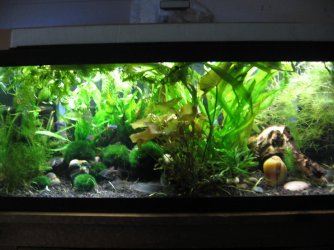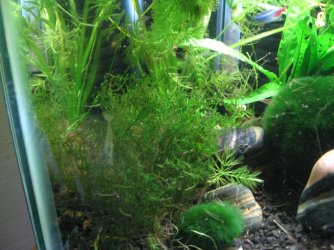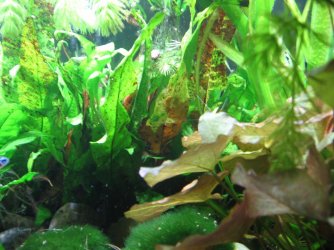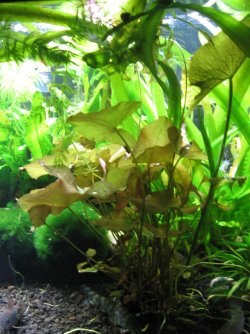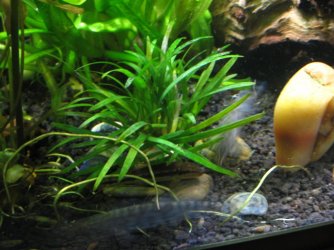I have a heavily planted 20 g long (set-up details at bottom of post) that had excellent plant growth for a couple of months, then things (for the plants) slowly started to go downhill.
Without even trying, I used to grow more hornwort, lily pads, Chiliensis than I knew what to do with, now the hornwort is about all gone. First the floating hornwort slowly, over weeks, months, turned brown and disintegrated, regrowing somewhat in spurts, then dying back, but trending slowly down. Meanwhile, for a long time, many rooted plants - like Aponogeton, Java Fern, Pond Lily, Chiliensis, Java Moss, Mondo Grass, grew well or at least remained stable, then first the Aponogeton, then the Mondo grass began to die off. Now, a few weeks later, even the last 5 in the previous list are not looking as good, mainly turning brown or yellow, leaves losing color, then disintegrating, Java Fern getting black spots all over, seems to be deteriorating. Only a couple of species - like "Marimo moss" and duckweed appear to be unaffected.
I have been using SeaChem Flourish and Fritz trace elements all along, but even increased doses make less and less, if any difference now. Weekly water changes of 60% used to do some good, but now have less effect, if any.
My nitrogen cycle tests were giving 0 or near 0 ppm for ammonia, nitrite, and nitrate, so I tried more extreme measures, and immediately ran into weird difficulties: Making an additional diy nitrate fertilizer from KN03 crystals, and using the Rotala Butterfly Nutrient Calculator
Per the Calculator results, I added 1.85 grams of KNO3 to my 20g long, aiming for 15 ppm KNO3, waited a couple of hours, retested for nitrate (the API Freshwater Master Test Kit 800) AND STILL GOT 0 ppm NO3!
I made a ridiculously strong sample of KNO3 solution to test, in order to assure that at least the test kit chemicals would change color, (the kit is NEW; chemicals all have date-codes showing they expire in 2025!) and that test "worked', at least to the extent of proving a color change was possible.
But it gets weirder:
After a day or so, I thought perhaps some of the plants looked just a bit greener, so on the assumption that Google search was not going to kill me, i.e. that 40 ppm NO3 was safe, I shot for 30 ppm by adding another 1.85 grams KNO3, waited, re-tested the water for NO3, using the same kit, AND STILL GOT 0 PPM NO3 !!
So question #1 would be : Anyone had trouble with the API Freshwater Master NO3 test or the Rotala calculator?
Suggestions for another NO3 test?
I'm guessing perhaps I could need iron supplementation, or CO2 injection to increase bio-available carbon, not nitrogen, but my Ph was 6.5 - 6.7 already, and that's too close to the lower limit.
The problem could also be the substrate; I have Eco-Complete, and have heard that this type of material loses its effectiveness after a while. Could I need to add laterite, clay shards or something ?
I should mention I have HARD water, ~ ph 7.6, Kh ~211 ppm as it goes into the tank, (dechlorinated w/ SeaChem Prime, oxygenated & stored for 7 days prior to use), and a large colony of many hundreds of Malaysian Trumpet snails in the substrate (mainly), and I know snails can lower ph a bit by extracting carbonate, but THAT much (7.6 - 6.7 or lower)? Probably not.....
I should mention all fish & invertebrates seem to be fine; no ich, no rot, except one or two fish do scratch a bit, as from a cilliate, but there are no visible signs of disease anywhere on them, & 3/4 of the fish do not scratch at all - only 1 loach of 3, 1 cory of 3, & the Back Ghost does get white scratches now and then, which disappear in a day or so, but which don't seem to correspond to where he scratches.
---------------------------------------------------------
Recent test results;
Temp; 79 F
Ammonia, Nitrite, Nitrate, all ~ 0 ppm (!?!)
ph 6.5 - 6.7
Kh ~17.9 ppm
Gh ~ 130 ppm
------------------------------------------------------
SET-UP:
20 gallon-long w/ glass top
Eco-Complete substrate
20-50 g AquaClear HOB
2 sponge filters, in rear corners, each has a "40g" TETRA air-pump on it (PLENTY of aeration !).
48 W, full-spectrum LED light, 16/8 day/night cycle w/ dawn/dusk feature, w/ blue night light.
LOTS of live plants, as above.
100W heater, temp constant ~ 79F
1 piece Mopani wood (adds a bit of tannin)
Weekly water change ~60%, HARD water
------------------------------------------------------------
STOCK:
1) 5-6 inch Black Ghost Knife
3) Yoyo Loaches, 2-3 inches long
3) Corydoras
1) 2-3 inch Chinese Algae Eater
1) Pleco, ~3-4 inches
6) Neon Tetras (weird, I know. but no problems)
~15) Ghost Shrimp
2) Nerite Snails
Several hundred Malaysian Trumpet Snails.
-----------------------------------------------------
Without even trying, I used to grow more hornwort, lily pads, Chiliensis than I knew what to do with, now the hornwort is about all gone. First the floating hornwort slowly, over weeks, months, turned brown and disintegrated, regrowing somewhat in spurts, then dying back, but trending slowly down. Meanwhile, for a long time, many rooted plants - like Aponogeton, Java Fern, Pond Lily, Chiliensis, Java Moss, Mondo Grass, grew well or at least remained stable, then first the Aponogeton, then the Mondo grass began to die off. Now, a few weeks later, even the last 5 in the previous list are not looking as good, mainly turning brown or yellow, leaves losing color, then disintegrating, Java Fern getting black spots all over, seems to be deteriorating. Only a couple of species - like "Marimo moss" and duckweed appear to be unaffected.
I have been using SeaChem Flourish and Fritz trace elements all along, but even increased doses make less and less, if any difference now. Weekly water changes of 60% used to do some good, but now have less effect, if any.
My nitrogen cycle tests were giving 0 or near 0 ppm for ammonia, nitrite, and nitrate, so I tried more extreme measures, and immediately ran into weird difficulties: Making an additional diy nitrate fertilizer from KN03 crystals, and using the Rotala Butterfly Nutrient Calculator
Per the Calculator results, I added 1.85 grams of KNO3 to my 20g long, aiming for 15 ppm KNO3, waited a couple of hours, retested for nitrate (the API Freshwater Master Test Kit 800) AND STILL GOT 0 ppm NO3!
I made a ridiculously strong sample of KNO3 solution to test, in order to assure that at least the test kit chemicals would change color, (the kit is NEW; chemicals all have date-codes showing they expire in 2025!) and that test "worked', at least to the extent of proving a color change was possible.
But it gets weirder:
After a day or so, I thought perhaps some of the plants looked just a bit greener, so on the assumption that Google search was not going to kill me, i.e. that 40 ppm NO3 was safe, I shot for 30 ppm by adding another 1.85 grams KNO3, waited, re-tested the water for NO3, using the same kit, AND STILL GOT 0 PPM NO3 !!
So question #1 would be : Anyone had trouble with the API Freshwater Master NO3 test or the Rotala calculator?
Suggestions for another NO3 test?
I'm guessing perhaps I could need iron supplementation, or CO2 injection to increase bio-available carbon, not nitrogen, but my Ph was 6.5 - 6.7 already, and that's too close to the lower limit.
The problem could also be the substrate; I have Eco-Complete, and have heard that this type of material loses its effectiveness after a while. Could I need to add laterite, clay shards or something ?
I should mention I have HARD water, ~ ph 7.6, Kh ~211 ppm as it goes into the tank, (dechlorinated w/ SeaChem Prime, oxygenated & stored for 7 days prior to use), and a large colony of many hundreds of Malaysian Trumpet snails in the substrate (mainly), and I know snails can lower ph a bit by extracting carbonate, but THAT much (7.6 - 6.7 or lower)? Probably not.....
I should mention all fish & invertebrates seem to be fine; no ich, no rot, except one or two fish do scratch a bit, as from a cilliate, but there are no visible signs of disease anywhere on them, & 3/4 of the fish do not scratch at all - only 1 loach of 3, 1 cory of 3, & the Back Ghost does get white scratches now and then, which disappear in a day or so, but which don't seem to correspond to where he scratches.
---------------------------------------------------------
Recent test results;
Temp; 79 F
Ammonia, Nitrite, Nitrate, all ~ 0 ppm (!?!)
ph 6.5 - 6.7
Kh ~17.9 ppm
Gh ~ 130 ppm
------------------------------------------------------
SET-UP:
20 gallon-long w/ glass top
Eco-Complete substrate
20-50 g AquaClear HOB
2 sponge filters, in rear corners, each has a "40g" TETRA air-pump on it (PLENTY of aeration !).
48 W, full-spectrum LED light, 16/8 day/night cycle w/ dawn/dusk feature, w/ blue night light.
LOTS of live plants, as above.
100W heater, temp constant ~ 79F
1 piece Mopani wood (adds a bit of tannin)
Weekly water change ~60%, HARD water
------------------------------------------------------------
STOCK:
1) 5-6 inch Black Ghost Knife
3) Yoyo Loaches, 2-3 inches long
3) Corydoras
1) 2-3 inch Chinese Algae Eater
1) Pleco, ~3-4 inches
6) Neon Tetras (weird, I know. but no problems)
~15) Ghost Shrimp
2) Nerite Snails
Several hundred Malaysian Trumpet Snails.
-----------------------------------------------------


